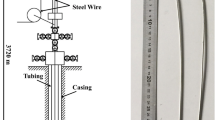Abstract
The wellhead flow control valve bodies which are the focal point of this failure case study were installed in some of the upstream facilities of Khangiran’s sour gas wells. These valve bodies have been operating satisfactorily for 3 years in wet H2S environment before some pits and cracks were detected in all of them during the periodical technical inspections. One failed valve body was investigated by chemical and microstructural analytical techniques to find out the failure cause and provide preventive measures. The valve body alloy was A216-WCC cast carbon steel. During investigation many cracks were observed on the inner surface of the valve body grown from the surface pits. The results indicate that flow control valve body failed due to combination of hydrogen-induced corrosion cracking and sulfide stress corrosion cracking. According to HIC and SSC laboratory tests and also with regard to cost of engineering materials, it was evident that the best alternative for the valve body alloy is A217-WC9 cast Cr–Mo steel.











Similar content being viewed by others
References
R.A. Carneiro, R.C. Ratnapuli, The influence of chemical composition and microstructure of API linepipe steels on hydrogen induced cracking and sulfide stress corrosion cracking. Mater. Sci. Eng. A357, 104–110 (2003)
J. Tang, Y. Shao, The effect of H2S concentration on the corrosion behavior of carbon steel at 90 °C. Corros. Sci. 52, 2050–2058 (2010)
A. Forder, M. Thew, D. Harrison, A numerical investigation of solid particle erosion experienced within oilfield control valves. Wear 216, 184–193 (1998)
R.S. Tresseder, in Stress Corrosion Cracking and Hydrogen Embrittlement of Iron Base Alloys, ed. by R.W. Staehle (NACE, Houston, TX, 1977), p. 147
K. Ume et al., Initiation and propagation morphology of sulfide stress corrosion cracking at welds on linepipe steels. Corrosion (1985) [paper 240, March 25–29, Boston, MA]
E. Ramirez, J.G. Gonzalez, Effect of microstructure on the sulfide stress cracking susceptibility of a high strength pipeline steel. Corros. Sci. 50, 3534–4354 (2008)
W.K. Kim, H.G. Jung, Relationship between hydrogen-induced cracking and type I sulfide stress cracking of high-strength linepipe steel. Scripta Mater. 62, 195–198 (2010)
G. Domizzi, G. Anteri, Influence of sulphur content and inclusion distribution on the hydrogen induced blister cracking in pressure vessel and pipeline steels. Corros. Sci. 43, 325–339 (2001)
T.Y. Jin, Z.Y. Liu, Y.F. Cheng, Effect of non-metallic inclusions on hydrogen-induced cracking of API5L X100 steel. Int. J. Hydrog. Energy 35, 8014–8021 (2010)
G.T. Park, S.U. Koh, Effect of microstructure on the hydrogen trapping efficiency and hydrogen induced cracking of linepipe steel. Corros. Sci. 50, 1865–1871 (2008)
NACE Standard MR175, Materials for use in H2S Containing Environments in Oil and Gas Production. (NACE, Houston, TX, 2001)
W.K. Kim, B.Y. Yang, Effect of environmental and metallurgical factors on hydrogen induced cracking of HSLA steels. Corros. Sci. 50, 3336–3342 (2008)
M. Al-Mansour, A.M. Al-Fantazi, Sulfide stress cracking resistance of API–X100 high strength low alloy steel. Mater. Des. 30, 4088–4094 (2009)
M. Zhao, Y. Shan, Investigation on the H2S-resistant behaviors of acicular ferrite and ultrafine ferrite. Mater. Lett. 57, 141–145 (2002)
H. Huang, J. Lee, Effect of H2S on the electrochemical behavior of steel weld in acidic chloride solutions. Mater. Chem. Phys. 58, 177–181 (1999)
H. Huang, W. Tsai, Cracking characteristics of A516 steel weldment in H2S containing environments. Mater. Sci. Eng. A 188, 219–227 (1994)
Acknowledgments
The authors wish to thank East Oil and Gas Production Company (EOGPC), the Research Council of Sharif University of Technology, and Razi Metallurgical Lab for supporting this work.
Author information
Authors and Affiliations
Corresponding author
Rights and permissions
About this article
Cite this article
Ziaei, S.M.R., Kokabi, A.H. & Mostowfi, J. Failure Analysis: Sulfide Stress Corrosion Cracking and Hydrogen-Induced Cracking of A216-WCC Wellhead Flow Control Valve Body. J Fail. Anal. and Preven. 14, 376–383 (2014). https://doi.org/10.1007/s11668-014-9810-x
Received:
Revised:
Published:
Issue Date:
DOI: https://doi.org/10.1007/s11668-014-9810-x




